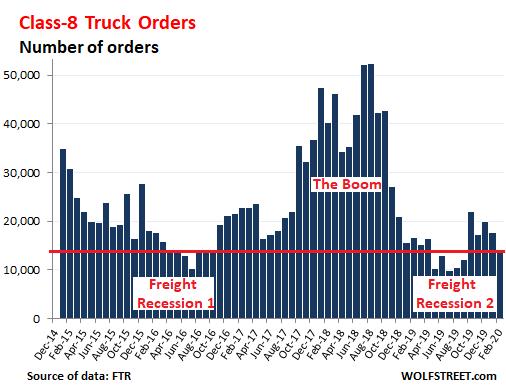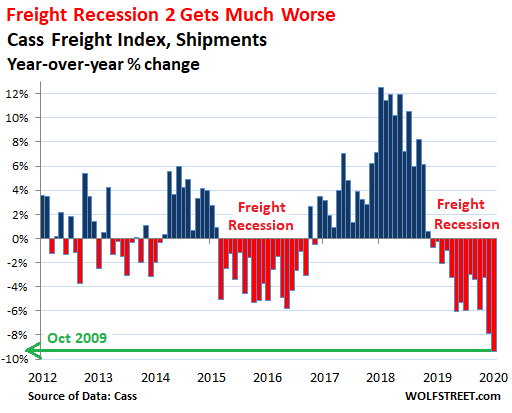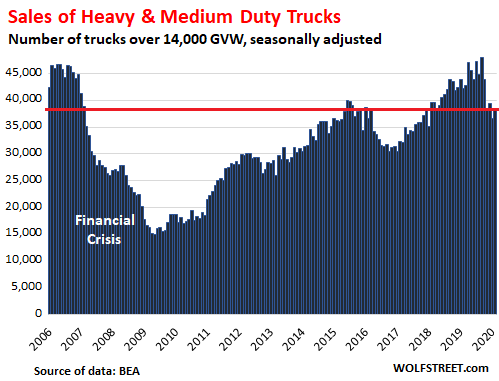But for its still pre-coronavirus quarter, Navistar reported that its Truck revenues collapsed by 31%.
By Wolf Richter for WOLF STREET.
So Navistar International reported Q1 results this morning. It swung to a net loss of $36 million in the quarter ended January 31, as total revenues plunged 24.5%, to $1.84 billion. Net sales in its Truck segment plunged 31% to $1.24 billion.
And new orders for trucks have essentially collapsed, which bodes ill for revenues going forward. These orders may be for units that have been sold to a specific customer, such as a trucking company, or for units built for dealer inventory to be sold eventually to a customer. These are the net orders (new orders minus cancellations) in Q1, and only school buses did well:
- Class 8 trucks: -83% to 2,600 units (14,900 a year ago)
- Class 6 and 7 medium-duty trucks: -72% to 3,200 (11,600 a year ago)
- School buses: +27% to 4,200 (3,300 a year ago)
And Navistar’s order backlog has plunged as well:
- Class 8 trucks: -56% to 13,800 units.
- Class 6 and 7 trucks: -63% to 7,100 units
- School buses: +34% to 4,300 units.
What keeps Navistar’s shares at an elevated level is an unsolicited buyout offer from TRATON Group, that caused NAV to jump 52% at the end of January. TRATON, a subsidiary of Volkswagen Group, is one of the largest truck and bus manufacturers in the world (MAN, Scania, and Volkswagen Caminhões e Ônibus).
Volkswagen Group spun off part of TRATON via an IPO at the end of July, 2019. Shares started trading in Frankfurt at €27 and closed today at €19.02, having plunged 30% in seven months.
For the US industry overall, orders for Class 8 trucks – the heaviest category of trucks – fell 18% in February from the already low levels a year ago, to 14,100 units, the lowest number of orders for any February since 2010, according to FTR Transportation Intelligence. For the past 12 months, there were 177,000 total orders for Class 8 trucks, down 64% from 497,000 orders in the year 2018.
“Fleets were already being very cautious in equipment purchases due to the flat freight market and slowing economy; now the COVID-19 virus has added to that uncertainty,” FTR said in the statement.

This downturn follows the historic boom in orders from late 2017 through much of 2018, when trucking companies reacted to the surging demand for transportation services that was fueled in part by companies wanting to front-run the new tariffs. But late 2018, shipment volume across all modes of transportation – by truck, rail, air, and barge – began its long decline on a year-over-year basis that has now turned into an ugly swoon.
In January, shipment volume of consumer and industrial goods, not including bulk commodities, by truck, rail, air, and barge dropped 9.4% compared to the already weak January a year earlier, according to the Cass Freight Index for Shipments, the 14th month in a row of year-over-year declines, and the steepest decline since October 2009. This chart shows the year-over-year percentage change of the index for shipment volume for each month through January 2020:

And trucking companies reacted to this decline in demand by slashing their orders. Then in February, the coronavirus became part of the decision-making mix.
“This is not good news for the trucking industry or the economy,” said Don Ake, VP commercial vehicles at FTR. “It appears fleets have decided to delay some orders until the health crisis has passed. There is no pressure for fleets to order more trucks since most carriers have enough capacity to handle current freight volumes.”
The Class 8 truck makers – Daimler’s Freightliner and Western Star; Paccar’s [PCAR] Peterbilt and Kenworth; Navistar International [NAV]; and Volvo Group’s Mack Trucks and Volvo Trucks – have responded to this downturn by announcing production cuts, accompanied by layoffs, starting in the second half last year.
Industry-wide sales to end-users are now plunging too. Sales lag orders by many months. During the ordering boom in 2018, the backlog at truck makers reached historic highs. Then, as orders collapsed by up to 80% year-over-year in 2019, truck makers ate through their backlog, producing trucks at capacity, and as these units were then sold, they generated record sales, even as orders for new trucks had already collapsed.
Sales of Class 8 trucks and of medium-duty Class 6 and 7 trucks (this measures all trucks with a gross vehicle weight over 14,000 pounds) dropped by 9% in February compared to a year ago, seasonally adjusted, to 38,500 trucks, after having plunged 17% year-over-year in January, the Bureau of Economic Analysis reported this morning.
It was only the fourth month in a row of year-over-year sales declines – and is just the beginning of the sales decline that follows with a lag the collapse in orders that began over a year ago:

“The market was already in a wait-and-see mode before the virus spread,” FTR’s Don Ake said, adding, “The current uncertainty has just made more fleets leery of taking on additional risks.”
The freight recession of 2019 – and the collapse in truck orders from the boom year 2018 – was rough enough. But now the very first effects of the coronavirus are being thrown on top of it.
United Airlines: “We are preparing for the possibility of further reductions to our schedules as the virus spreads.” Read… Just How Bad Is It Going to Get for US Airlines?